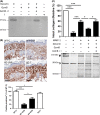Granzyme B mediates both direct and indirect cleavage of extracellular matrix in skin after chronic low-dose ultraviolet light irradiation
- PMID: 25495009
- PMCID: PMC4326907
- DOI: 10.1111/acel.12298
Granzyme B mediates both direct and indirect cleavage of extracellular matrix in skin after chronic low-dose ultraviolet light irradiation
Abstract
Extracellular matrix (ECM) degradation is a hallmark of many chronic inflammatory diseases that can lead to a loss of function, aging, and disease progression. Ultraviolet light (UV) irradiation from the sun is widely considered as the major cause of visible human skin aging, causing increased inflammation and enhanced ECM degradation. Granzyme B (GzmB), a serine protease that is expressed by a variety of cells, accumulates in the extracellular milieu during chronic inflammation and cleaves a number of ECM proteins. We hypothesized that GzmB contributes to ECM degradation in the skin after UV irradiation through both direct cleavage of ECM proteins and indirectly through the induction of other proteinases. Wild-type and GzmB-knockout mice were repeatedly exposed to minimal erythemal doses of solar-simulated UV irradiation for 20 weeks. GzmB expression was significantly increased in wild-type treated skin compared to nonirradiated controls, colocalizing to keratinocytes and to an increased mast cell population. GzmB deficiency significantly protected against the formation of wrinkles and the loss of dermal collagen density, which was related to the cleavage of decorin, an abundant proteoglycan involved in collagen fibrillogenesis and integrity. GzmB also cleaved fibronectin, and GzmB-mediated fibronectin fragments increased the expression of collagen-degrading matrix metalloproteinase-1 (MMP-1) in fibroblasts. Collectively, these findings indicate a significant role for GzmB in ECM degradation that may have implications in many age-related chronic inflammatory diseases.
Keywords: aging; collagen; extracellular matrix; fibronectin; granzyme B; matrix metalloproteinase; photoaging; skin; ultraviolet light.
© 2014 The Authors. Aging Cell published by the Anatomical Society and John Wiley & Sons Ltd.
Figures






References
-
- Abraham T, Carthy J, McManus B. Collagen matrix remodeling in 3-dimensional cellular space resolved using second harmonic generation and multiphoton excitation fluorescence. J. Struct. Biol. 2010;169:36–44. - PubMed
-
- Administration on Aging. Projected Future Growth of the Older Population: older Population as a Percentage of the Total Population: 1900 to 2050. Washington, DC, USA: Administration on Aging; 2010.
-
- Bosset S, Bonnet-Duquennoy M, Barré P, Chalon A, Kurfurst R, Bonté F, Schnébert S, Le Varlet B, Nicolas JF. Photoageing shows histological features of chronic skin inflammation without clinical and molecular abnormalities. Br. J. Dermatol. 2003;149:826–835. - PubMed
Publication types
MeSH terms
Substances
Grants and funding
LinkOut - more resources
Full Text Sources
Other Literature Sources
Molecular Biology Databases

